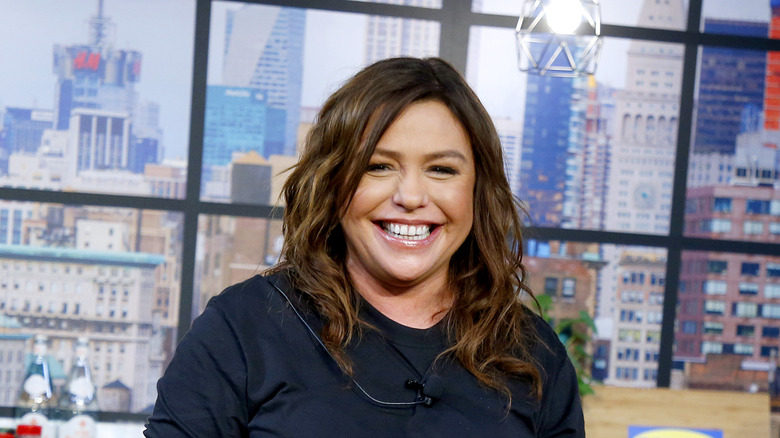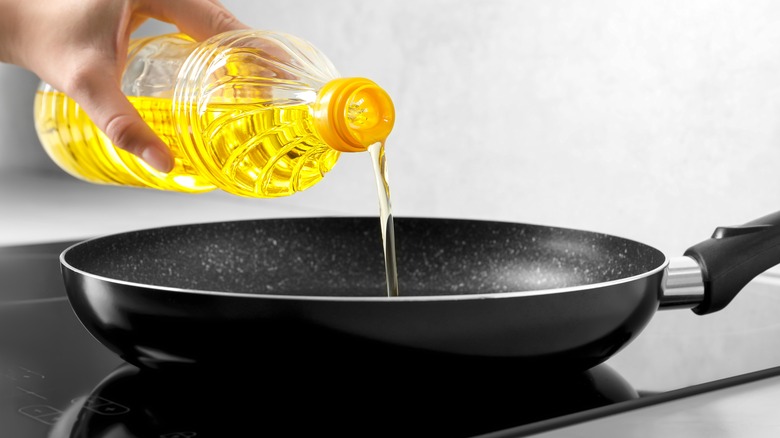Rachael Ray's Quick Trick To Tell When Frying Oil Is Hot Enough
So you put your calamari, corn fritter, chicken cutlet — or any other breaded food — into the frying oil too soon. You were sure the oil was hot enough; but there's your dinner, floating in a pool of barely-bubbling oil, unable to achieve that desired brown crust. It's a common mistake to make. After all, it can be difficult to determine when your oil has hit the perfect frying temperature by just looking at it. Luckily, Rachael Ray has an easy trick to help you ensure that your oil is ready for frying.
Most home cooks know that the former "30-Minute Meals" host is a fount of knowledge regarding kitchen shortcuts, and Ray's advice extends to the frying pan as well. In a video shared on Rachael Ray's Facebook page, the television host shared the perfect hack to check that your frying oil is at the correct temperature, and all you'll need is a wooden spoon.
Simply place the wooden handle of a spoon (or a spatula, or anything with a wooden handle) into your oil. If you see bubbles emerging from the submerged wood, it means that your oil is ready to go. Next time you're ready to cook a batch of something delicious (or "delish," as Ray might say), grab a wooden utensil and get to frying.
How to get a handle on the right temperature
The ideal temperature range for oil when frying is around 325 degrees Fahrenheit to 375 degrees Fahrenheit. This will allow your food to fry without immediately scalding or becoming soggy and absorbing too much oil. Of course, if you have a deep-fry thermometer on hand, you can always use it to check your oil's exact temp. However, just because you don't have a thermometer handy doesn't mean you should forgo frying. The best part about Rachael Ray's tip is that no extra gadgets are required, and it's a perfect shortcut for anyone wanting to execute the perfect fry without a thermometer.
If you're frying in multiple batches, you can also use this hack to ensure that your cooking oil hasn't cooled down too much in between. While checking for bubbles on the wooden handle, you'll want to look for signs that your oil is either too hot or too cool. If there are plenty of bubbles forming around the wood that come to the surface in a rapid (but not splashing) motion, then you're good to go. But if there are only a few bubbles, or no bubbles at all, the oil isn't hot enough for frying yet. If your oil begins to bubble aggressively, however, that's a sign that it's too hot; and you might want to turn the dial back on your heat before you start frying.
Keeping things safe, and your wood clean
Rachael Ray's wooden spoon trick is more than just easy to do. It's also less likely to cause dangerous oil splashes when compared to other methods of checking oil temperature. One of these methods involves sprinkling small amounts of water in your pan and checking for bubbles. This, like the wooden spoon method, is easy to do. However, the water method can also be a safety hazard. The water immediately turns into vapor when it hits the pan, causing the oil to splash upwards. This can potentially lead to burns. But aside from the risk of burns, adding too much water could cause a dangerous overflow of oil, potentially leading to a fire.
Ray's wooden spoon hack, on the other hand, does not carry the same danger, as the kitchen utensil can withstand higher temperatures. Additionally, wood does not cause the same violent reaction when added to oil. However, you should take certain measures to clean your wooden utensil after using it to test your oil, as wood can be prone to buildup. But you will want to avoid the popular method of boiling your wooden spoons because it can cause splitting and shrinkage. Once your spoon is clean, it will be ready for its next task — whether that be scooping up potato salad, or serving as an impromptu thermometer.


